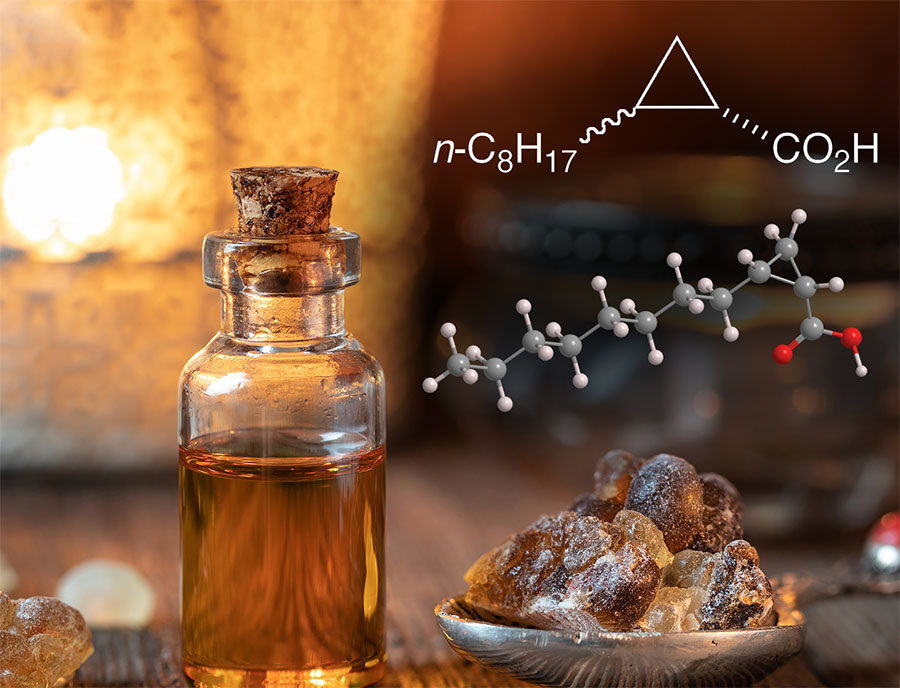What molecules are we?

Frankincense, also called olibanum, is a resin obtained from trees in the genus Boswellia that grow in Africa and Asia. One of the first aromatic materials used by humans, it dates to the late fourth millennium BCE. It and myrrh1 are familiar as gifts offered to the Christ child by the Magi in the Christian gospel.
Surprisingly, the main odor ingredients in frankincense were only recently discovered. In the 2016 seminal article on this discovery, Nicolas Baldovini and collaborators at the University of Nice Sophia Antipolis (France), Albert Vieille SA (Vallauris, France), and the University of Turin (Italy) reported the isolation and characterization of (+)-cis- and (+)-trans-2-octylcyclopropanecarboxylic acids, which they called olibanic acids after frankincense’s alternative name. The 3-D image above represents the more fragrant cis isomer.
The olibanic acids constitute only ≈0.2 wt% of the oil derived from frankincense; but the authors’ olfactory tests showed that they are responsible for the aroma of the resin, which they describe as the “smell of old churches”. The researchers synthesized the two (+)-diastereomers as well as their (–)-counterparts, which do not exist in frankincense. The synthetic (+)-diastereomers are identical with the natural compounds that were extracted from B. carterii and B. frereana, species that grow in mountainous regions on both sides of the Gulf of Aden and the Red Sea.
This holiday season, give thanks to Baldovini and his colleagues for solving the mystery of frankincense!
1. See next week’s Molecule of the Week.
Olibanic acid hazard information
| Hazard class* | GHS code and hazard statement | |
|---|---|---|
| Skin sensitization, category 1 | H317—May cause an allergic skin reaction | |
Serious eye damage/eye irritation, category 2A | H319—Causes serious eye irritation | |
*Globally Harmonized System (GHS) of Classification and Labeling of Chemicals. Explanation of pictograms.
Molecules in the News
Fenethylline1 is a combination of two drugs, the central nervous system stimulant amphetamine2 and the phosphodiesterase inhibitor theophylline3. It is synthesized by connecting amphetamine and theophylline with a two-carbon chain.
Fenethylline, sold under the trade name Captagon, was developed in the 1960s as an alternative to amphetamine for treating attention deficit hyperactivity disorder (ADHD) and depression. Although its incidence of abuse was low, it was banned in most countries in the 1980s.
In the 21st century, fenethylline/Captagon arose as a drug used by terrorists to give them extra energy, euphoria, and, some say, suppression of human feelings as they kill their victims. A 2015 article in the Israeli newspaper Haaretz reported that the Islamic State used Captagon manufactured by Hezbollah in Lebanon in its attacks. Then last month, Haaretz asserted that Captagon, now made in Syria, was used by Hamas in the October 7 slaying of 1200 Israelis. The article pointed out that antisemitism, the “main drug” used by the terrorists, was merely amplified by Captagon.
KT-4744 is a “degrader molecule” under development by Kymera Therapeutics (Cambridge, MA) for treating inflammatory skin conditions. Degrader molecules fight disease by tagging harmful proteins for destruction. In this case, KT-474 degrades the protein interleukin-1 receptor–associated kinase 4 (IRAK4), which is associated with inflammation.
Kymera recently published the results of a Phase 1 clinical trial that showed that orally administered KT-474 is safe and tolerable in subjects with or without the targeted skin diseases atopic dermatitis and hidradenitis suppurativa. The next step for Kymera and development partner Sanofi (Paris) is a Phase 2 trial to determine the drug’s effectiveness and potential side effects.
1. CAS Reg. No. 3736-08-1.
2. CAS Reg. No. 300-62-9.
3. CAS Reg. No. 58-55-9.
4. CAS Reg. No. 2768975-62-6.
Molecules in the News
MOTW highlights molecules that appear in major news outlets. See this week's edition below.
This molecule was suggested by a reader. We present almost all of the molecules suggested by our readers. If you have a molecule you would like us to consider, please send us a message. And thank you for your interest in Molecule of the Week! —Ed.
Olibanic acid fast facts
| CAS Reg. No. | 15898-87-0 |
| SciFinder nomenclature | Cyclopropane-carboxylic acid, 2-octyl- |
| Empirical formula | C12H22O2 |
| Molar mass | 198.30 g/mol |
| Appearance | Colorless oil |
| Boiling point | Not reported |
| Water solubility | Not reported |

Learn more about this molecule from CAS, the most authoritative and comprehensive source for chemical information.
Molecule of the Week needs your suggestions!
If your favorite molecule is not in our archive, please send us a message. The molecule can be notable for its current or historical importance or for any quirky reason. Thank you!
Stay Ahead of the Chemistry Curve
Learn how ACS can help you stay ahead in the world of chemistry.

